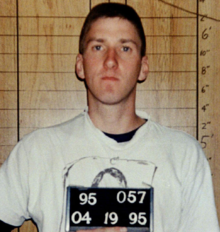
Back تيموثي مك فاي Arabic تيموثى مك فاى ARZ Timothy McVeigh AST Timoti Makvey Azerbaijani টিমোথি ম্যাকভেই Bengali/Bangla Timothy McVeigh Catalan Timothy McVeigh Czech Timothy McVeigh Danish Timothy McVeigh German Τίμοθι ΜακΒέι Greek
Timothy James McVeigh (April 23, 1968 – June 11, 2001) was an American domestic terrorist who masterminded and perpetrated the Oklahoma City bombing on April 19, 1995.[7][8] The bombing killed 168 people, including 19 children, injured 684, and destroyed one-third of the Alfred P. Murrah Federal Building.[9][10][11] It remains the deadliest act of domestic terrorism in U.S. history.[12]
A Gulf War veteran, McVeigh became radicalized by anti-government beliefs. He sought revenge against the United States federal government for the 1993 Waco siege, as well as the 1992 Ruby Ridge incident. McVeigh expressed particular disapproval of federal agencies such as the Bureau of Alcohol, Tobacco, and Firearms (ATF) and the Federal Bureau of Investigation (FBI) for their handling of issues regarding private citizens. He hoped to inspire a revolution against the federal government, and he defended the bombing as a legitimate tactic against what he saw as a tyrannical government.[13] He was arrested shortly after the bombing and indicted on 160 state offenses and 11 federal offenses, including the use of a weapon of mass destruction. He was found guilty on all counts in 1997 and sentenced to death.[14]
McVeigh was executed by lethal injection on June 11, 2001, at the Federal Correctional Complex in Terre Haute, Indiana. His execution, which took place just over six years after the offense, was carried out in a considerably shorter time than for most inmates awaiting execution.[15]
- ^ Cite error: The named reference
McVeigh word essaywas invoked but never defined (see the help page). - ^ https://www.fbi.gov/history/famous-cases/oklahoma-city-bombing
- ^ Shariat, Sheryll; Mallonee, Sue; Stidham, Shelli Stephens (December 1998). Oklahoma City Bombing Injuries (PDF) (Report). Injury Prevention Service, Oklahoma State Department of Health. pp. 2–3. Retrieved 21 October 2024.
- ^ Shariat, Sheryll; Mallonee, Sue; Stidham, Shelli Stephens (December 1998). Oklahoma City Bombing Injuries (PDF) (Report). Injury Prevention Service, Oklahoma State Department of Health. pp. 2–3. Retrieved 21 October 2024.
- ^ Cite error: The named reference
washingtonpostwas invoked but never defined (see the help page). - ^ Cite error: The named reference
trutv7was invoked but never defined (see the help page). - ^ Eatwell, Roger; Mudde, Cas, eds. (2004). Western Democracies and the New Extreme Right Challenge. Routledge Studies in Extremism and Democracy. London: Routledge. p. 178. ISBN 978-0-415-55387-2.
- ^ Flowers, R. Barri; Flowers, H. Lorraine (2004). Murders in the United States: Crimes, Killers and Victims of the Twentieth Century. McFarland & Company. p. 106. ISBN 0-7864-2075-8.
- ^ https://memorialmuseum.com/experience/their-stories/those-who-were-killed/
- ^ Mallonee, S.; Shariat, S.; Stennies, G.; Waxweiler, R.; Hogan, D.; Jordan, F. (1996-08-07). "Physical Injuries and Fatalities Resulting From the Oklahoma City Bombing". JAMA: The Journal of the American Medical Association. 276 (5): 382–387. doi:10.1001/jama.1996.03540050042021. ISSN 0098-7484.
- ^ Shariat, Sheryll; Mallonee, Sue; Stidham, Shelli Stephens (December 1998). Oklahoma City Bombing Injuries (PDF) (Report). Injury Prevention Service, Oklahoma State Department of Health. pp. 2–3. Retrieved 21 October 2024.
- ^ Levine, Mike; Margolin, Josh; Hosenball, Alex; Wagnon Courts, Jenny (6 October 2020). "Nation's deadliest domestic terrorist inspiring new generation of hate-filled 'monsters,' FBI records show". ABC News. Retrieved 21 May 2022.
- ^ Cite error: The named reference
mcveigh_deadwas invoked but never defined (see the help page). - ^ Cite error: The named reference
cnn 3-29-01was invoked but never defined (see the help page). - ^ "Time on Death Row". Death Penalty Information Center. Archived from the original on 2021-08-12. Retrieved 2021-08-13.
